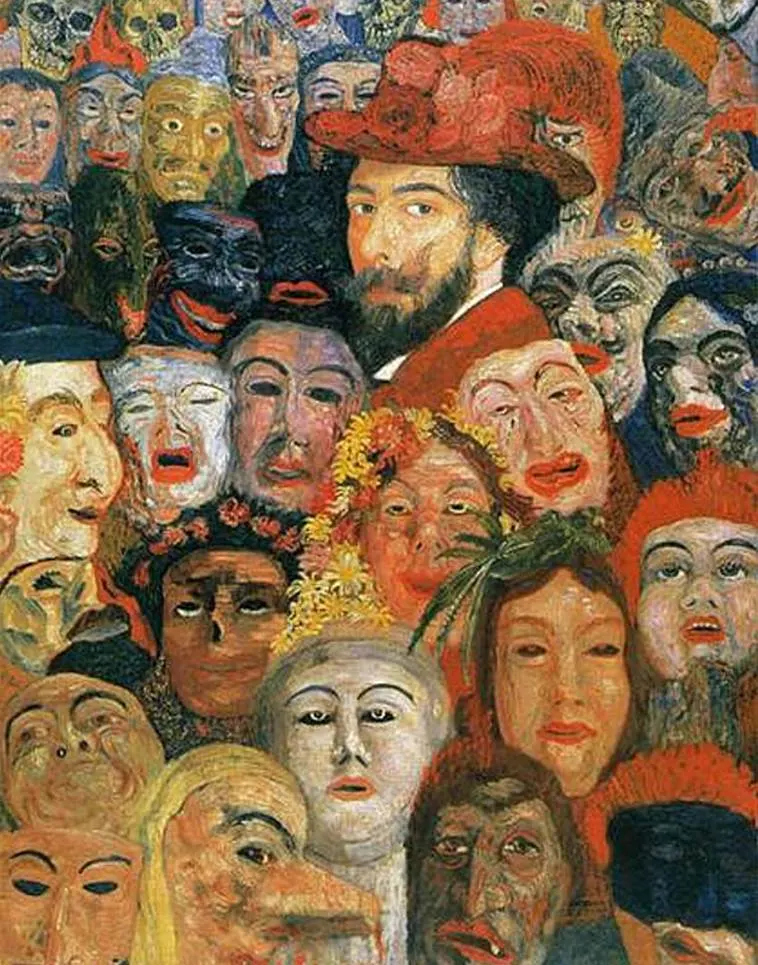When this Belgian artist started producing peculiar paintings full of symbolism and absurdity in the late 19th century, his works were classified as scandalous and shocking.
James Ensor (1860-1949) was a Symbolist artist who became a major influence on both Expressionist artists and Surrealist artists.
He was born to Engish parents in Brussels and lived and worked most of his career in the Belgian coastal city of Ostend.
He was one of the founding members of Les XX, an artistic group of about 20 Belgian artists who organized annual exhibitions.
When a monumental painting of his was rejected by the group he co-founded, he held a lifelong grudge and often ridiculed it in his works.
The often disturbing paintings that he produced were certainly ahead of their time and can be classified as major influences on Modernism.
In this article, you’ll discover some of the most famous James Ensor paintings so you can learn all about this fascinating artist.
1. Christ’s Entry Into Brussels in 1889
- Date created: 1888
- Dimensions: 252.7 × 430.5 centimeters (99.5 × 169.5 inches)
- Location: Getty Museum, Los Angeles, United States
Christ’s Entry Into Brussels in 1889 is an enormous painting by James Ensor that literally overflows with absurdities. It’s a parody of the Biblical story in which Jesus Christ enters Jerusalem on a donkey, an event celebrated on Palm Sunday.
Ensor transported this story, which is the prelude to the Passion of Christ, to Brussels, the capital city of his native Belgium. The painting is full of figures wearing masks, a recurring subject in the works of the artist. It has been in the collection of the Getty Museum in Los Angeles since 1987.
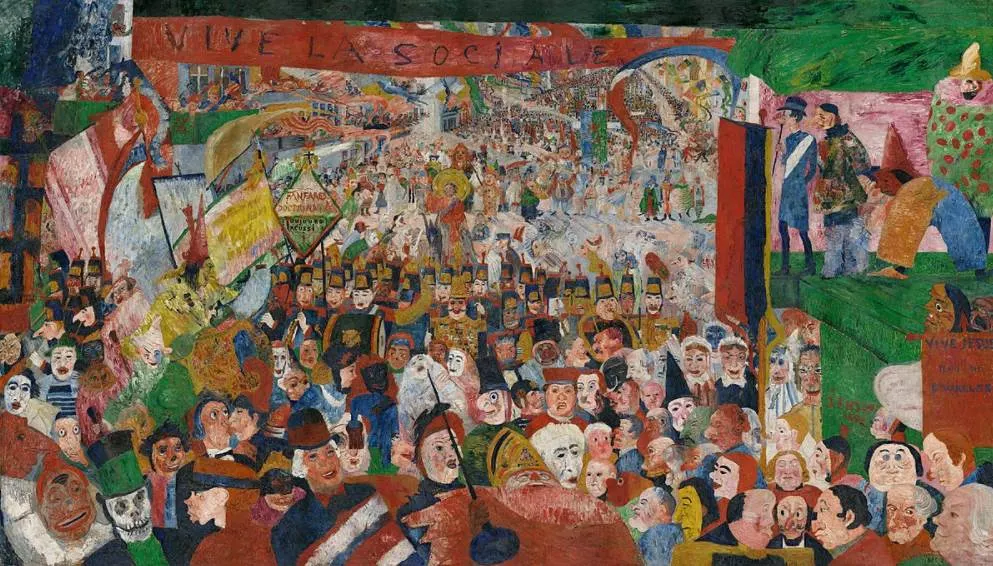
2. The Rooftops of Ostend
- Date created: 1884
- Dimensions: 149 × 207 centimeters (59 × 81 inches)
- Location: Royal Museum of Fine Arts Antwerp, Antwerp, Belgium

The Rooftops of Ostend is an early work by James Ensor, a tie when he was still experimenting with Impressionist painting techniques. He painted this view from his studio on the third floor of his parental home in his native Ostend.
The hazy view and the unclear buildings make it hard to determine which part of Ostend that he depicted. This in combination with the fact that the city looks much different than it does today makes it impossible to judge. It’s one of three cityscapes that he produced depicting the view from his studio.

3. The Intrigue
- Date created: 1890
- Dimensions: 90 × 149 centimeters (35 × 59 inches)
- Location: Royal Museum of Fine Arts Antwerp, Antwerp, Belgium
The Intrigue is the title of a painting that provides a closer view of the same type of absurd figures that Ensor included in his Magnum Opus “Christ’s Entry Into Brussels in 1889.” He completed it just 2 years after the huge painting that defines his career.
The painting features 11 figures that are wearing masks. The peculiar figures in combination with a remarkable contrast of colors transform this into a painting that can be defined as a “Grotesque Group Portrait.” It’s one of many Ensor paintings that is on the official inventory of Flemish masterpieces.

4. Skeletons Fighting over a Hanged Man
- Date created: 1891
- Dimensions: 59 × 74 centimeters (23 × 29 inches)
- Location: Royal Museum of Fine Arts Antwerp, Antwerp, Belgium
Skeletons Fighting over a Hanged Man is a painting that depicts a disturbing scene that takes place on a stage. Two skeletons that are wearing women’s clothes are seen fighting with objects usually associated with those used by angry women such as brooms and umbrellas.
This absurd scene takes place while a dead body hangs nearby with the inscription “civet,” the French word to describe “hare stew.” The entrances to both sides of the stage are occupied by masked figures carrying knives. A common interpretation of the work is that the dead body represents Ensor himself, the fighting skeletons the art critics who judge his paintings, and the people the general public.
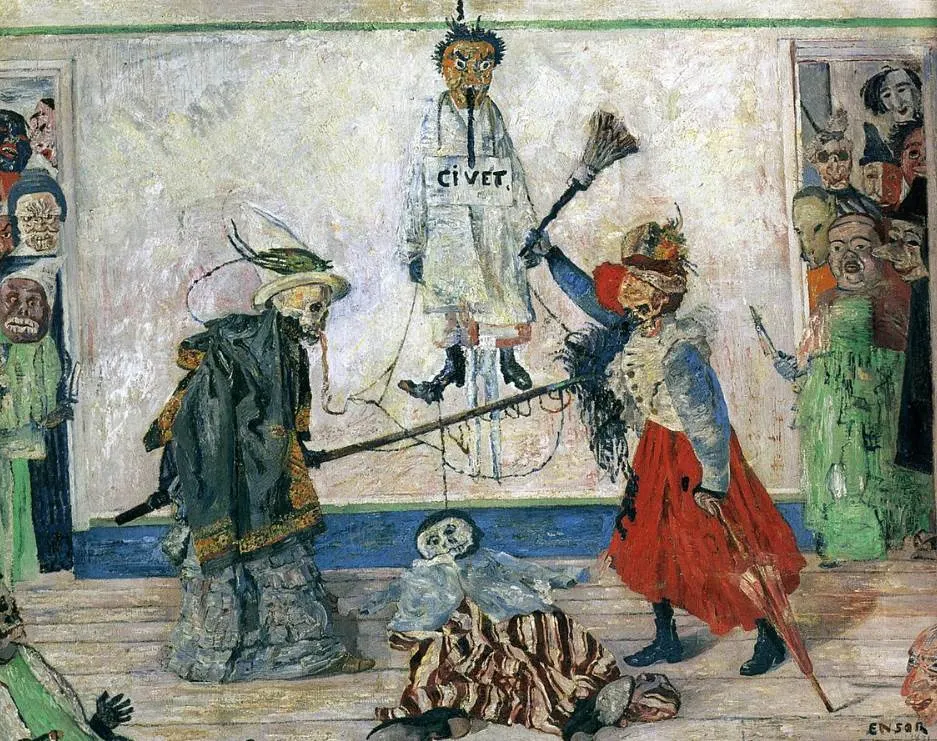
5. The Man of Sorrows
- Date created: 1891
- Dimensions: 20 × 15 centimeters (7.9 × 5.9 inches)
- Location: Royal Museum of Fine Arts Antwerp, Antwerp, Belgium
The Man of Sorrows is a very small, yet very disturbing painting that depicts Jesus Christ. The work was based on a similar painting by the Early Netherlandish artist Aelbrecht Bouts (1452-1549) which has the same title.
Although bloody as well, the painting by Bouts is a lot less graphic than Ensor’s painting. It wasn’t the first time that the Belgian artist produced a painting of Jesus Christ that can be described as being possessed by a demon. Ensor combined the bloody face of Jesus with a mask used in the Japanese Noh theater.
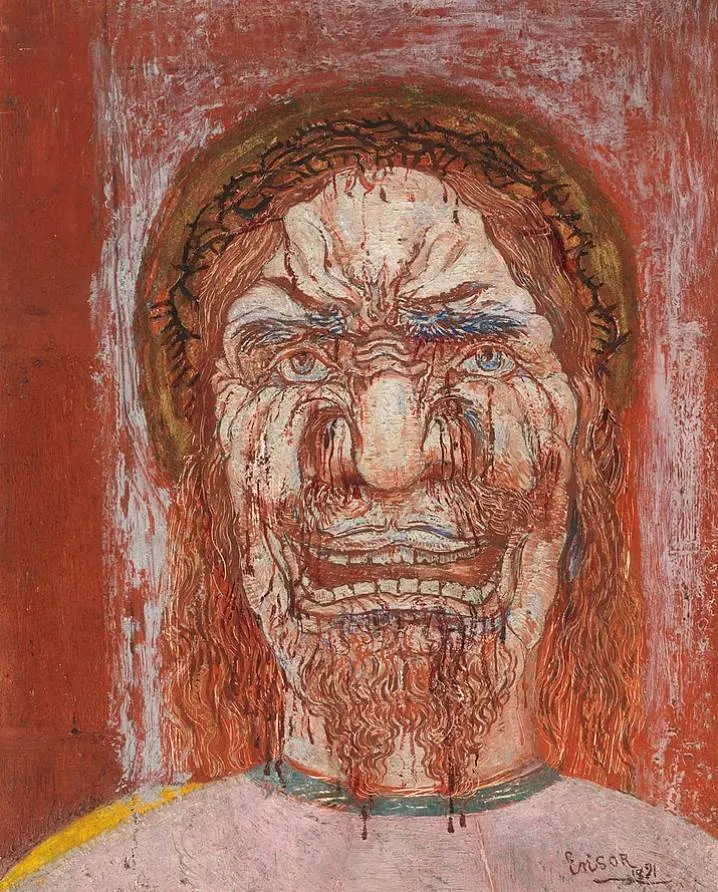
6. Masks Confronting Death
- Date created: 1888
- Dimensions: 81.3 x 100.3 centimeters (32 x 39.5 inches)
- Location: MoMA, New York City, United States
Masks Confronting Death is a title that accurately describes what is depicted. The central figure is a skeleton that represents death and it’s surrounded by multiple figures wearing peculiar masks. One of the figures can be seen wearing blue glasses while another has an incredibly long nose.
The recurring subject of masks can be explained by the fact that the ground floor of Ensor’s home featured a story where curious masks were being sold. These weird items allowed him to experiment with illogical colors and expressionism which, in turn, laid the foundation for modern artists of future generations.
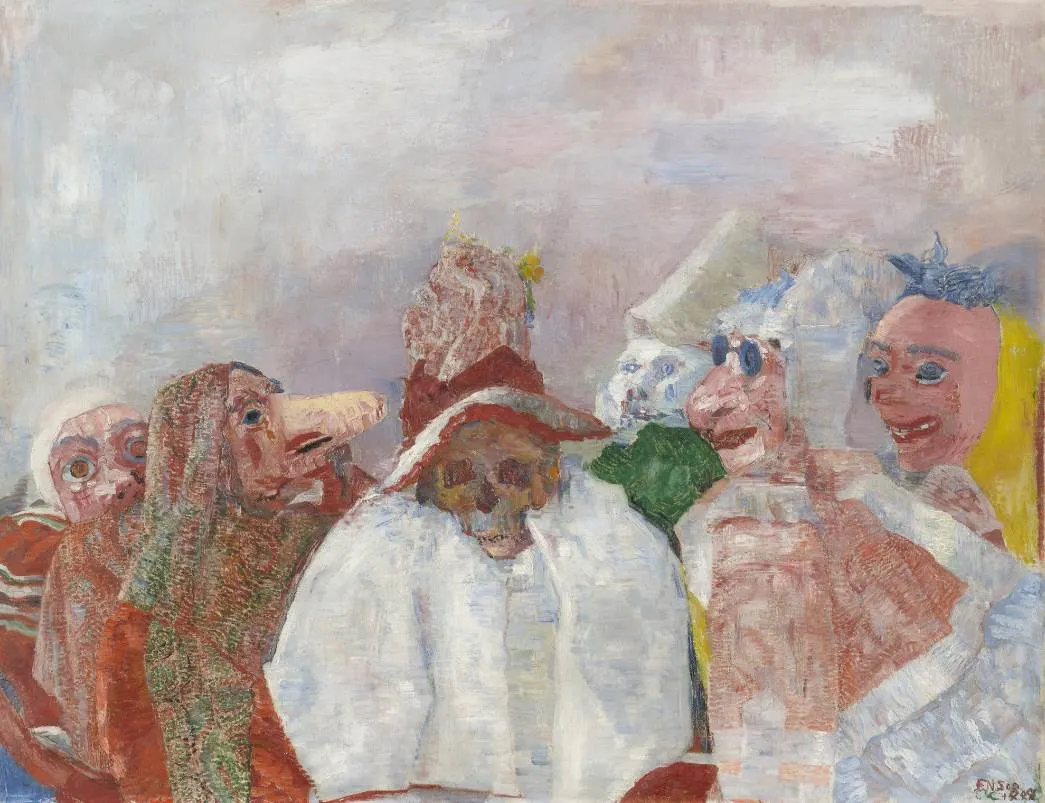
7. Skeletons Warming Themselves
- Date created: 1889
- Dimensions: 74.8 x 60 centimeters (29.43 x 23.62 inches)
- Location: Kimbell Art Museum, Fort Worth, United States
Skeletons Warming Themselves is yet another absurd painting in which we can see a group of skeletons who are warming themselves around a stove. The painting is even more farcical than it initially looks because the stive features the words “Pas de Feu” and “En Trouverez Vous Demain?”
This translates from French to “No Fire” and “Will you find any tomorrow?” The skeletons are located inside an artist’s studio and have several possessions such as a palette and brush, a violin, and a lamp. These are most probably symbols for art, music, and literature.
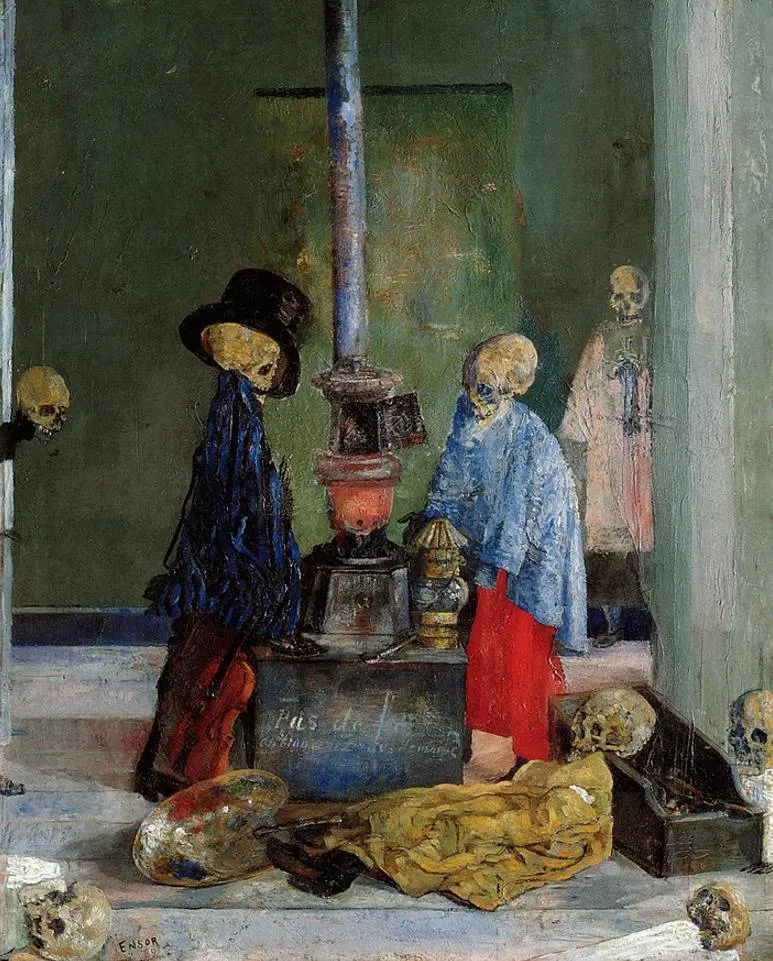
8. Comical Repast (Banquet of the Starved)
- Date created: 1917-1918
- Dimensions: 115.6 x 145.4 centimeters (45.5 x 57.25 inches)
- Location: MET Museum, New York City, United States
Comical Repast (Banquet of the Starved) is a painting with a double title because the artist described this work with both titles during his lifetime. It’s a puzzling work that was completed during the final years of World War I and might be interpreted as a critique of the war.
Art historians assume that it reflects the artist’s critique of the German occupation of Belgium during the war, something he experienced firsthand. The scene is an allegory of the Last Supper in which the meal consists of insects and raw onion. This is a symbol of the precarious situation during the war which resulted in famine, especially in urban areas.
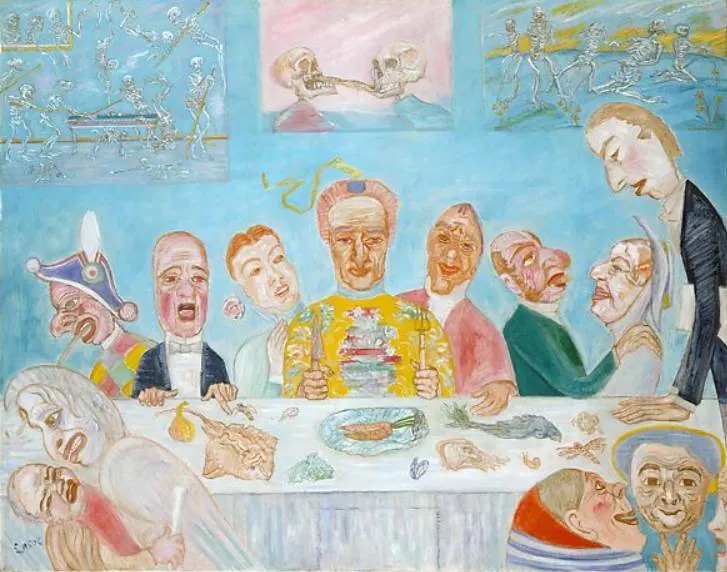
9. The Oyster Eater
- Date created: 1882
- Dimensions: 207 × 150 centimeters (81 × 59 inches)
- Location: Royal Museum of Fine Arts Antwerp, Antwerp, Belgium
The Oyster Eater is another painting by James Ensor that was produced before he started focusing on subjects that overflow with symbolism. This Impressionist painting depicts the artist’s sister Miche who is feasting on a lavish dinner of oysters and wine.
Just like some of Ensor’s painting overflow with skeletons and figures wearing masks, this table features an abundance of items, including food, wine, flowers, and plates. The painting was rejected for the Antwerp Salon of 1882 because of the sexual overtone of a single woman eating a plate of oysters.
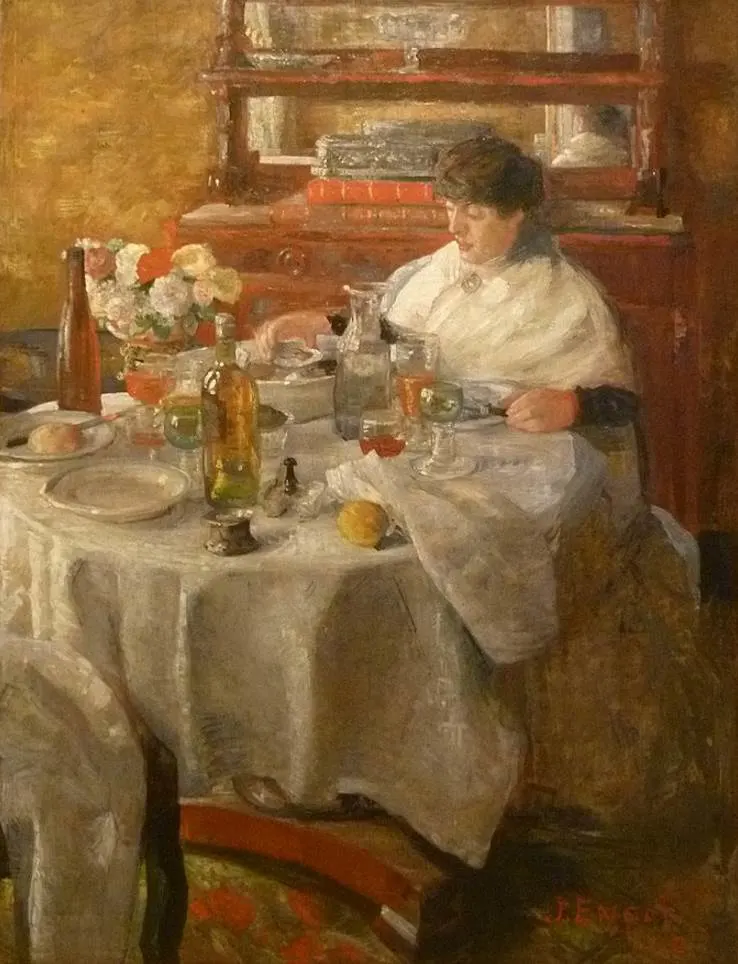
10. Self-Portrait with Masks
- Date created: 1899
- Dimensions: 117 x 82 centimeters (46 x 32.2 inches)
- Location: Menard Art Museum, Komaki, Japan
Self-Portrait with Masks features a large number of figures of which only the heads are visible. They are wearing the typical masks while some skeletons can be seen as well. Ensor painted himself triumphantly in the middle of the upper section wearing a red hat.
James Ensor looks very human compared to the large number of hideous figures that surround him. This has been interpreted as being a symbolic reference to the artist being unable to fit into a particular category. Leaving the artistic group Les XX was the perfect example of this.
